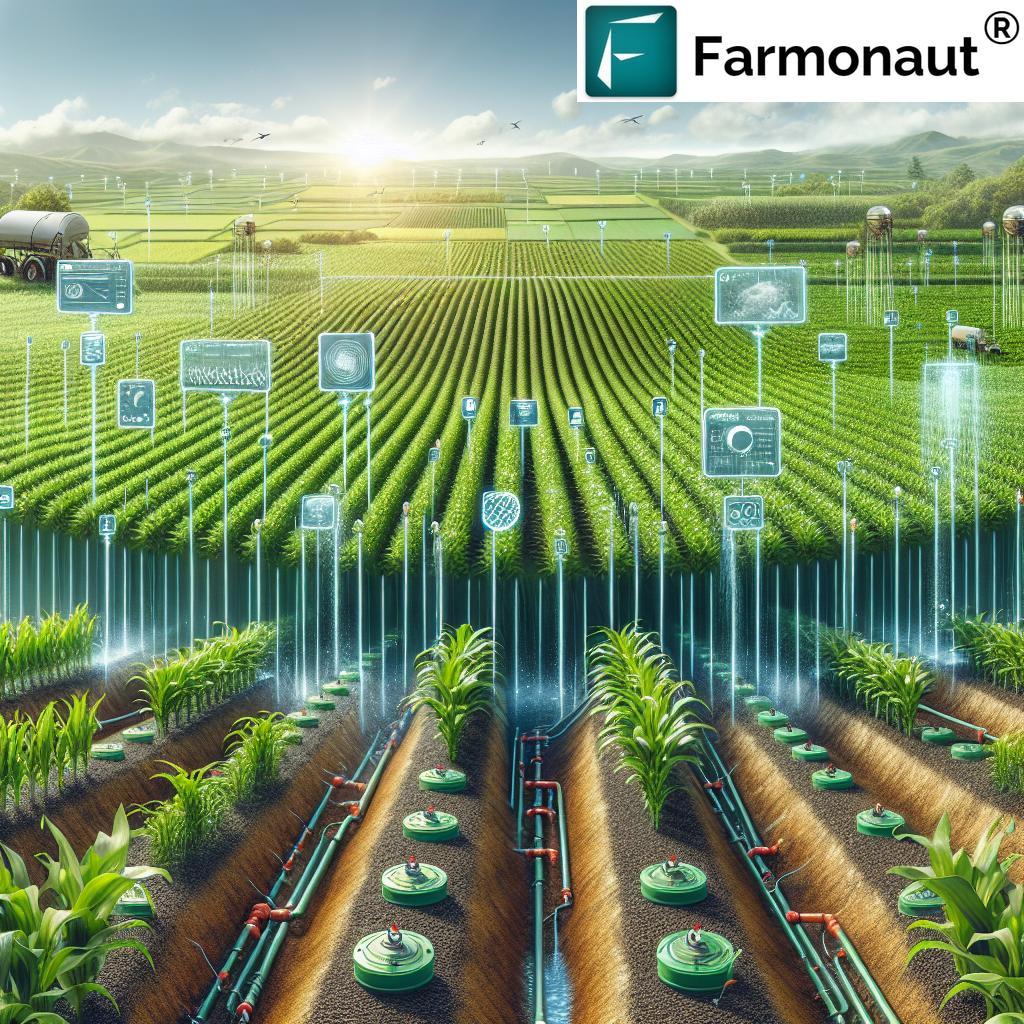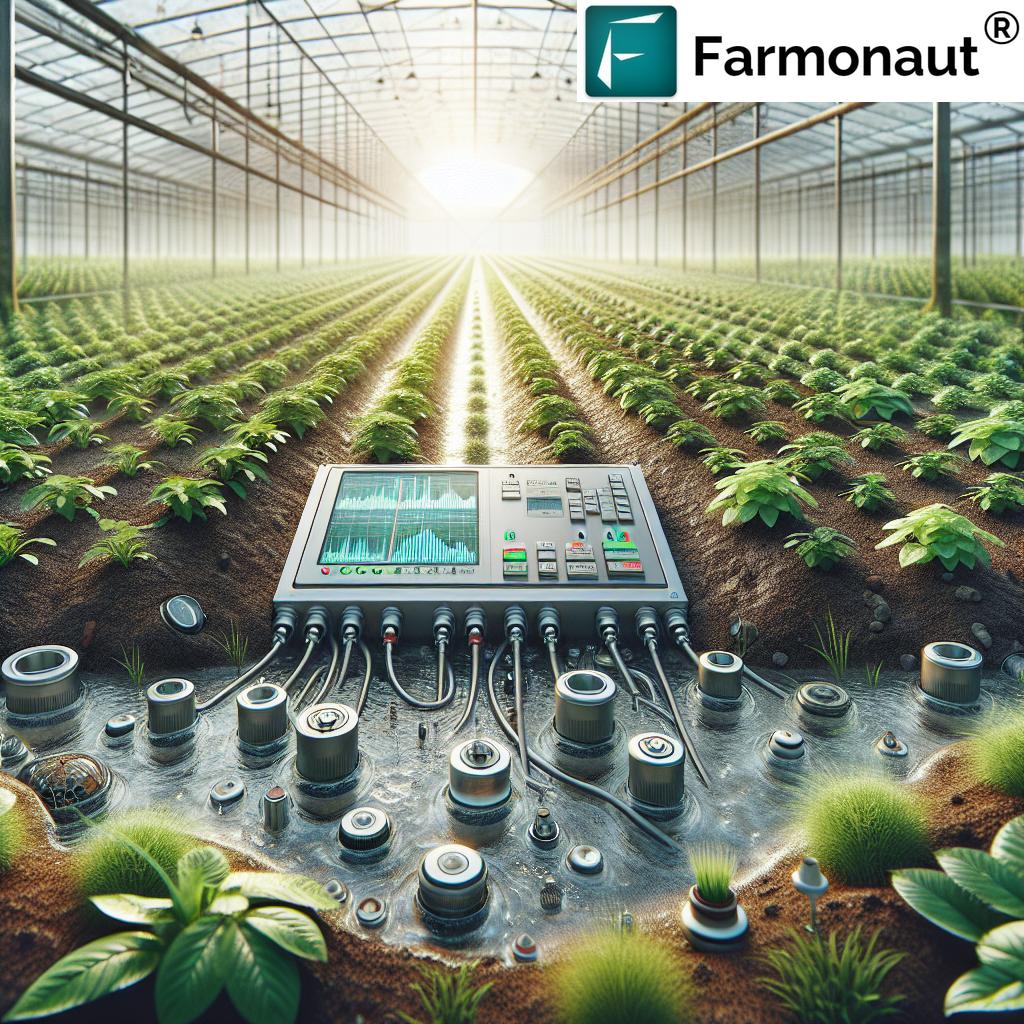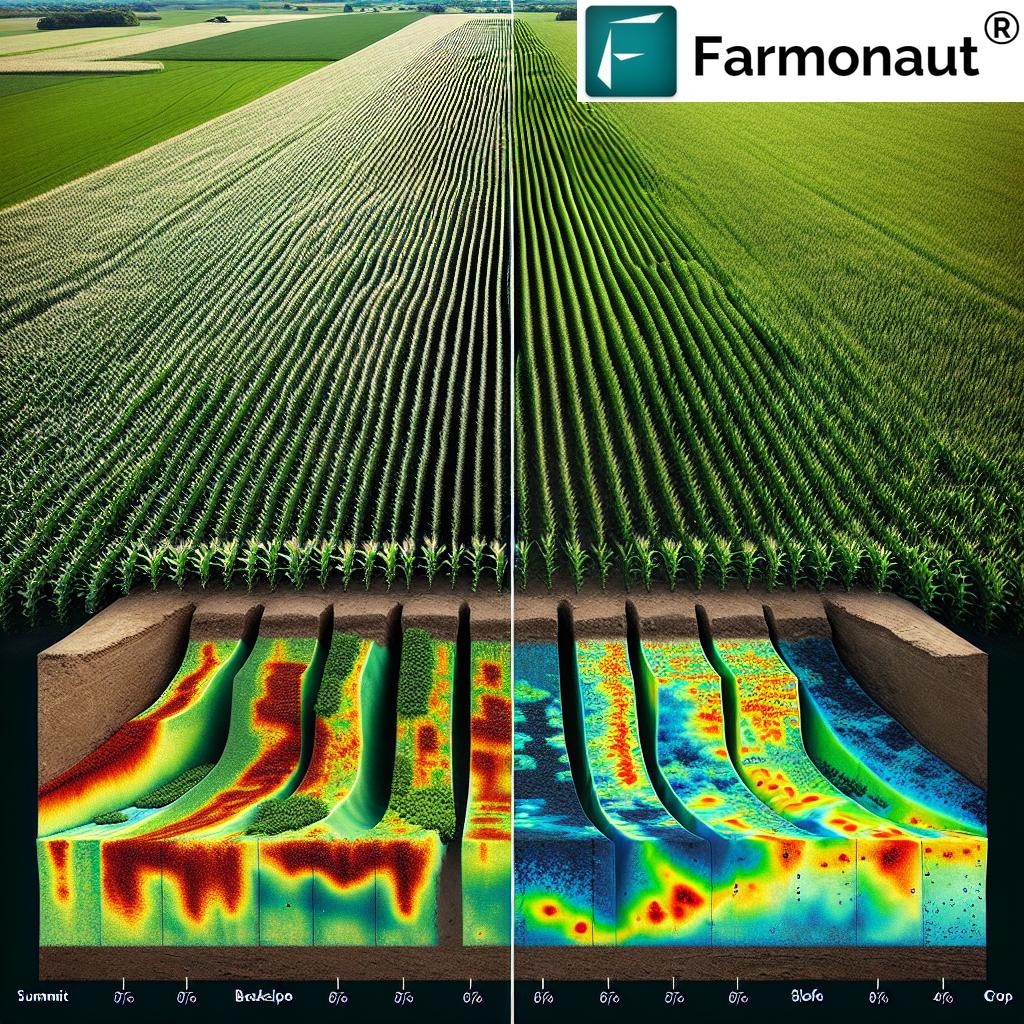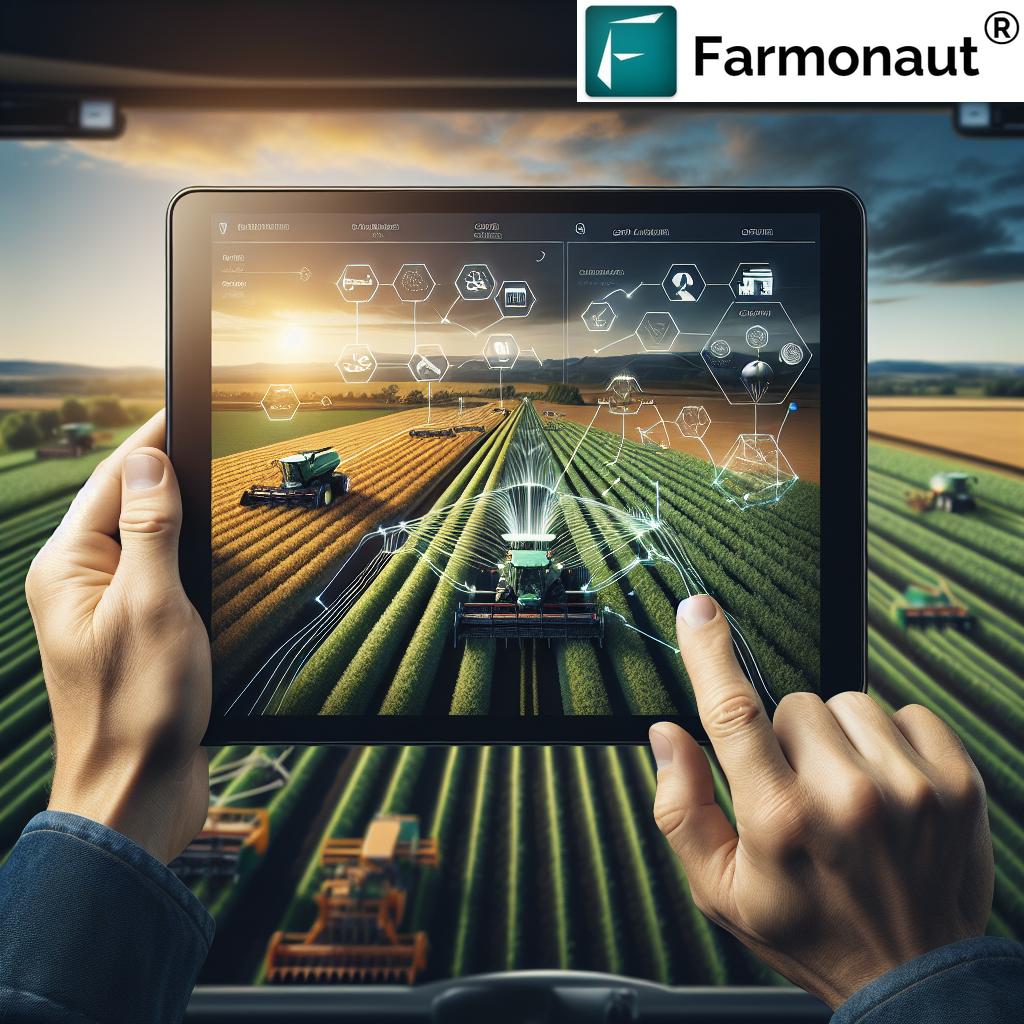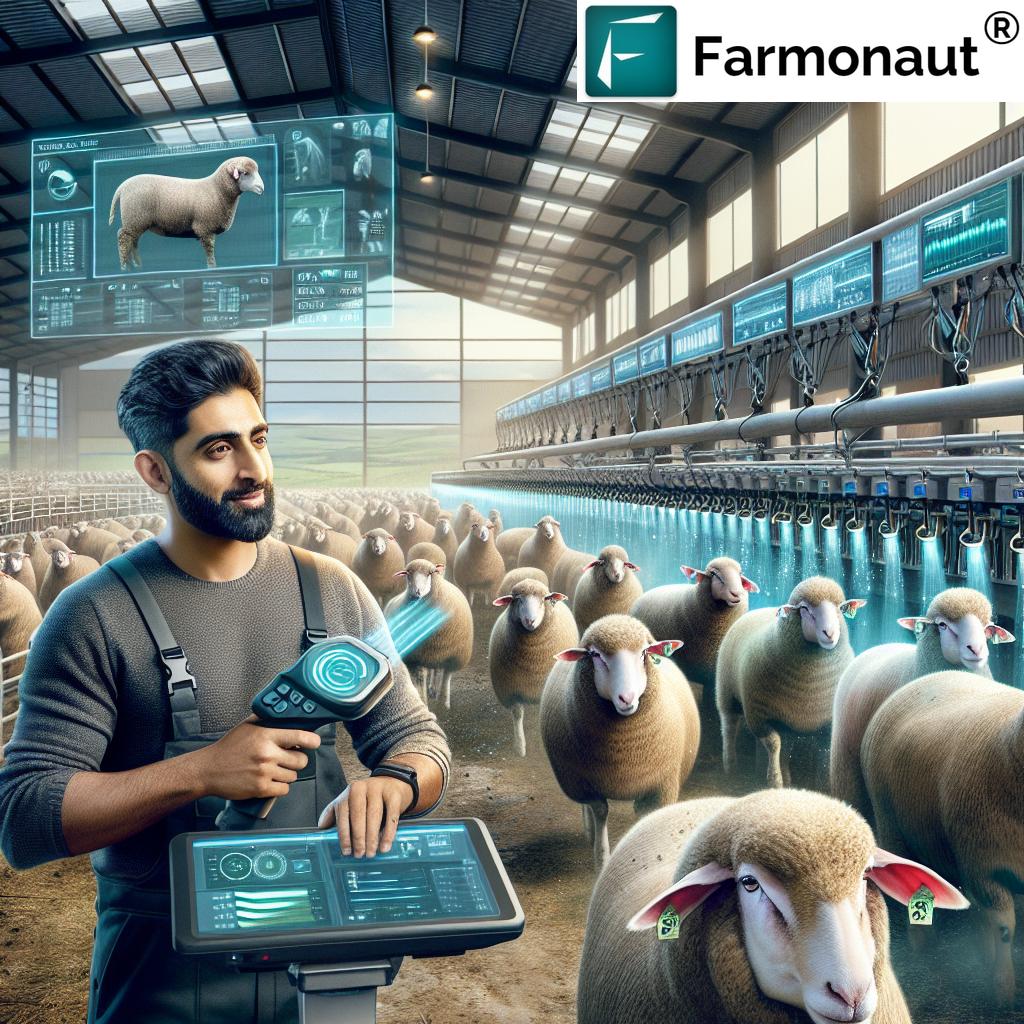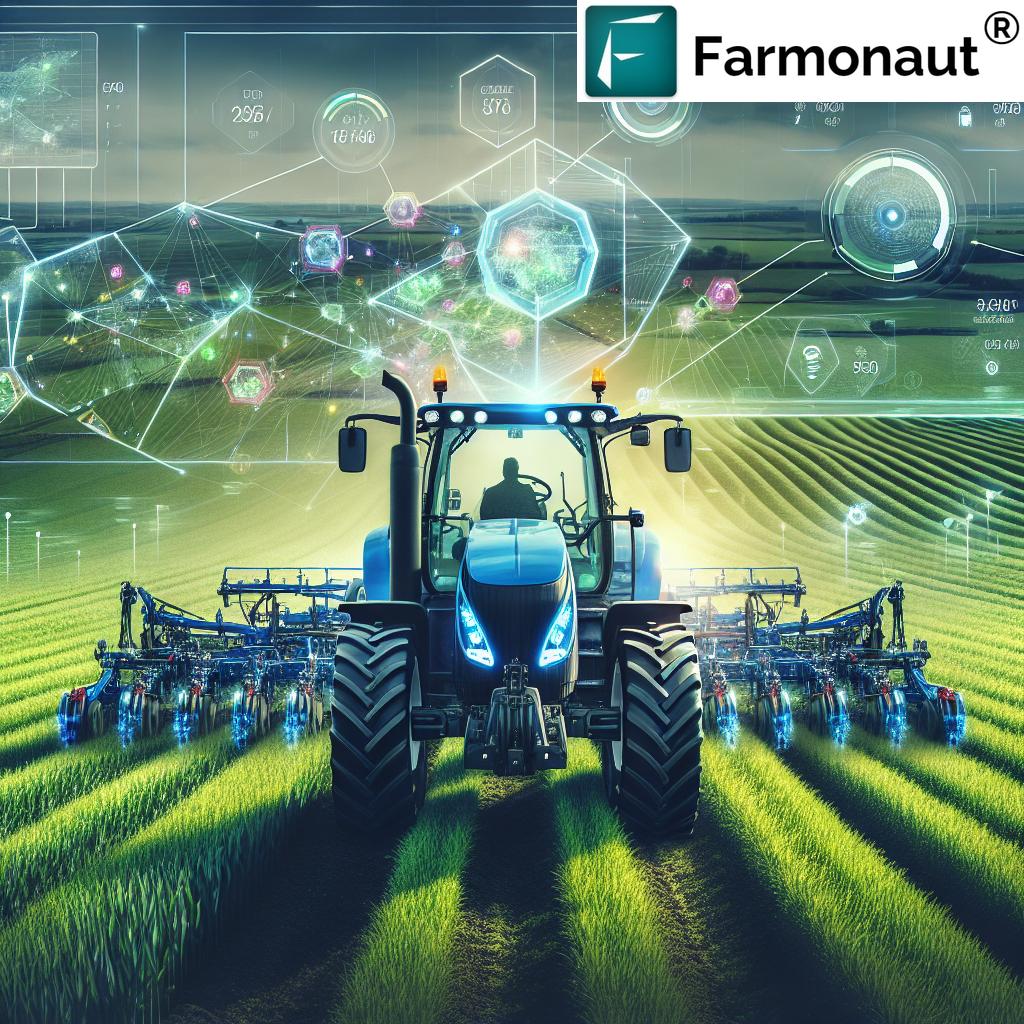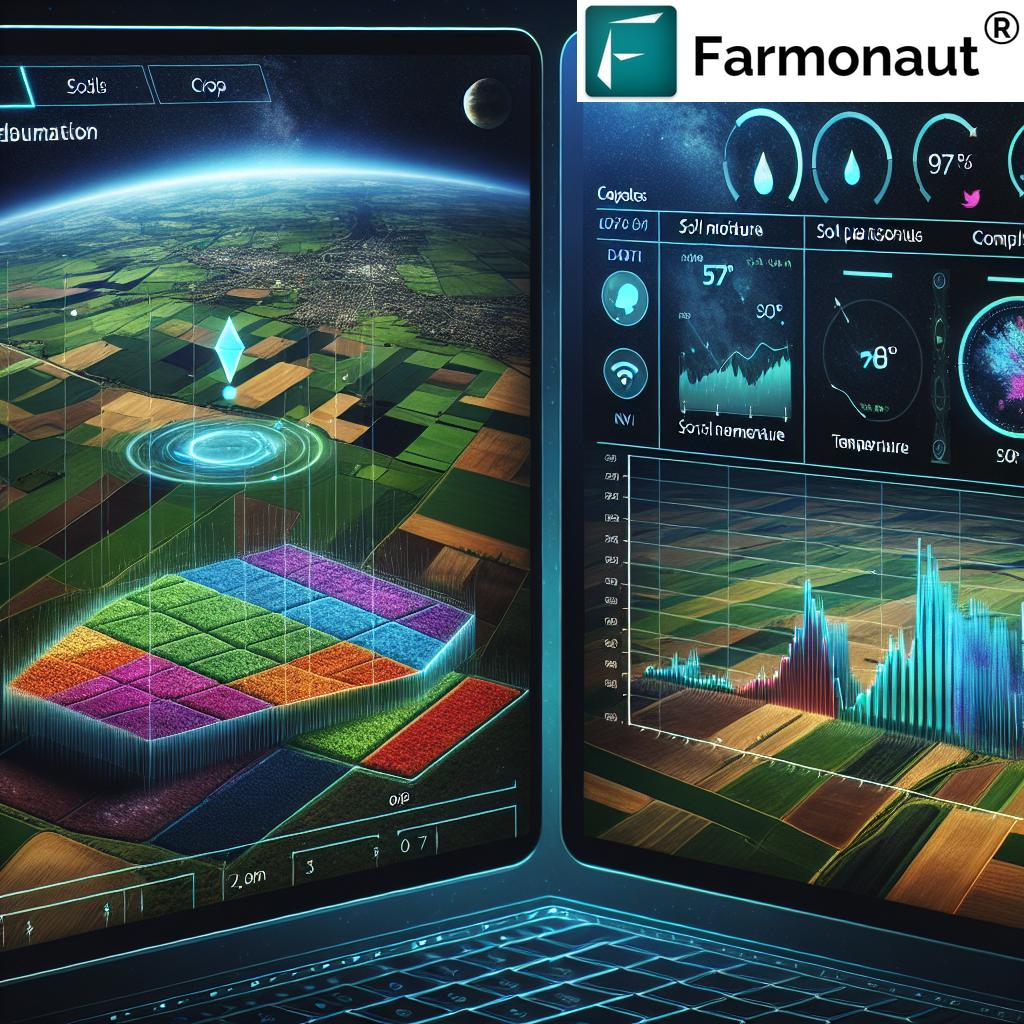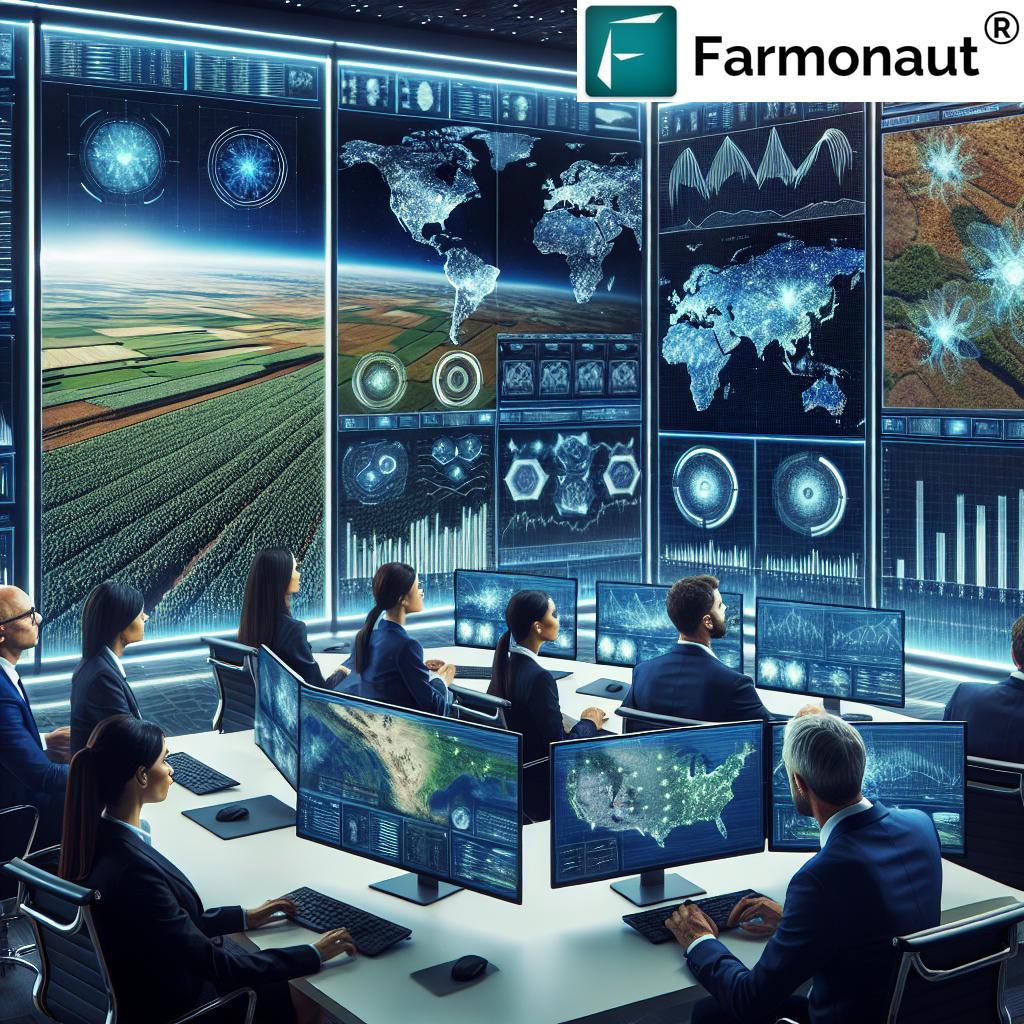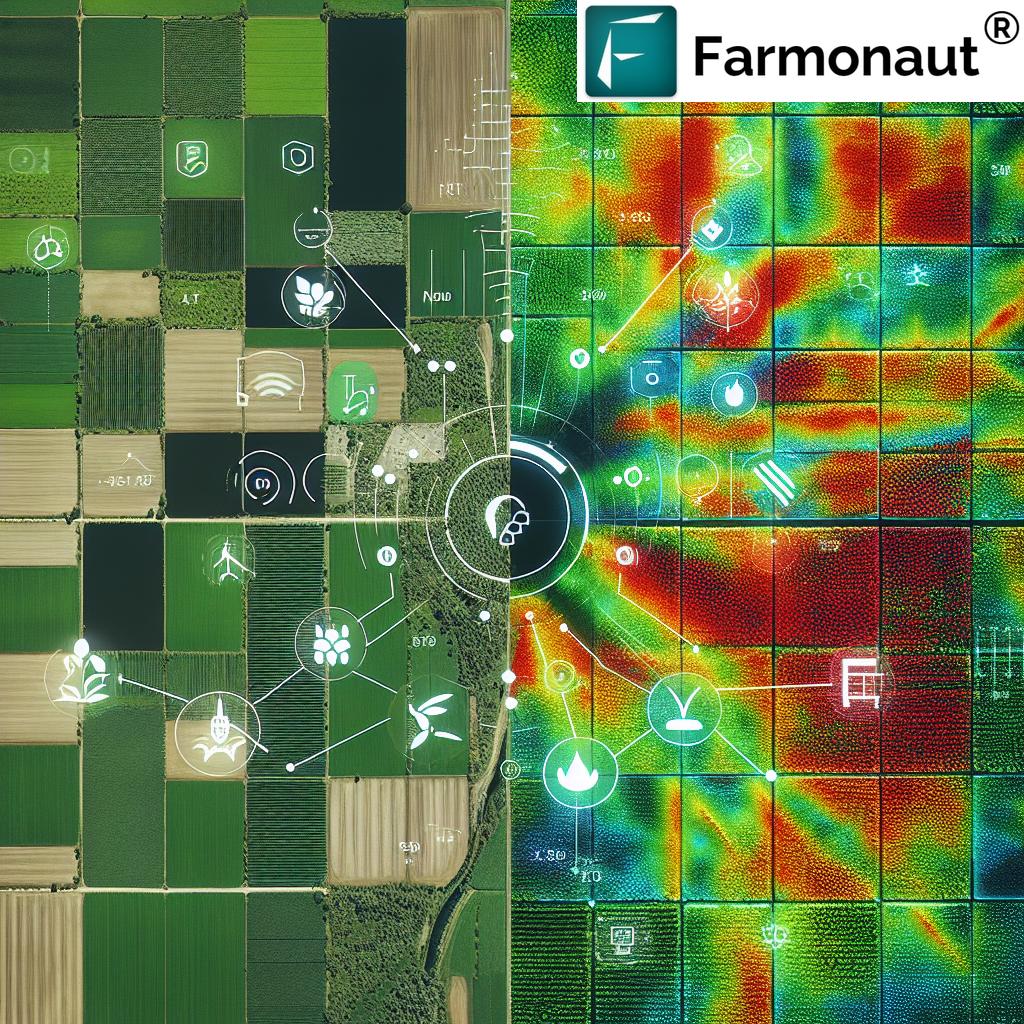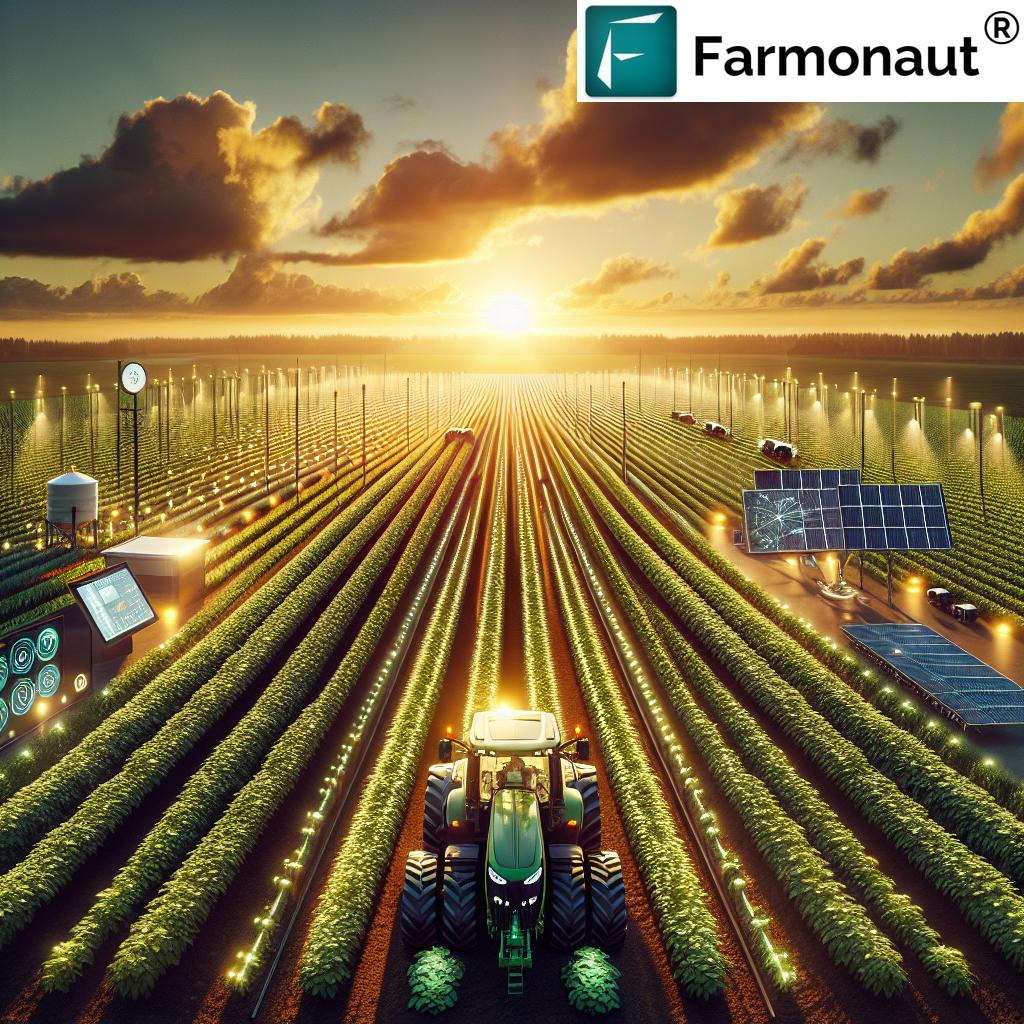Smart Irrigation Market: 2024 Trends & Sustainability
Table of Contents
- Introduction: The Evolution of the Smart Irrigation Market
- Understanding Smart Irrigation: Technologies & Key Concepts
- Market Growth & Adoption: Global Smart Irrigation Trends 2024
- Technological Components of Smart Irrigation Systems
- The Key Benefits of Smart Irrigation Technologies
- Challenges & Limitations Facing Smart Irrigation Adoption
- Comparison Table: Leading Smart Irrigation Technologies & Market Impact (2024)
- Farmonaut’s Role in Advancing Smart Irrigation & Precision Agriculture
- The Future of Smart Irrigation: 2024 and Beyond
- FAQ – Smart Irrigation Market, Adoption, and Sustainable Agriculture
Introduction: The Evolution of the Smart Irrigation Market
The global agricultural sector is undergoing a pivotal transformation, driven by a surge of technology adoption aimed at enhancing efficiency, productivity, and most importantly, sustainability. In 2024, the smart irrigation market leads the charge, with precision agriculture technologies revolutionizing how water is managed across farms worldwide. Smart irrigation systems are increasingly recognized as essential for addressing water scarcity, improving crop yields, and reducing environmental impacts—cornerstones of sustainable agricultural practices.
In this comprehensive guide, we explore smart irrigation trends, technologies, and the road ahead. We’ll delve deep into how real-time data, sensors, and automated irrigation solutions are enabling farmers to make optimal decisions, tackle climate challenges, and drive advances in crop yield improvement methods—across North America, Europe, Asia Pacific, and emerging regions.
For those seeking seamless access to advanced farm management and precision irrigation advisory, we recommend exploring our 
 apps or the
apps or the  for real-time, data-driven tools designed for everyone from individual farmers to government bodies worldwide.
for real-time, data-driven tools designed for everyone from individual farmers to government bodies worldwide.
Understanding Smart Irrigation: Technologies & Key Concepts
What is Smart Irrigation?
Smart irrigation refers to the integration of advanced technologies—like sensors, automated controllers, IoT, and AI-driven analytics—to precisely manage water distribution in farming, forestry, and sometimes urban landscaping. Unlike traditional methods that follow *fixed schedules* or rely on human observation, smart systems monitor real-time factors including:
- Soil moisture levels using dedicated soil moisture sensors
- Ambient weather conditions via climate stations or satellites
- Crop-specific water requirements at different growth stages
This data empowers **precision irrigation**, where **optimal amounts of water** are delivered **exactly when and where needed**, maximizing efficiency and reducing wastage.
How Does Smart Irrigation Contrast With Traditional Systems?
Traditional irrigation tends to stick to rigid, **time-based schedules**, which can result in:
- High **water wastage** due to over-irrigation or unnecessary cycles
- Poor **crop yield improvement methods** due to limited responsiveness to soil/crop needs
- Potential degradation of soil quality over time
In contrast, **smart systems** continuously **monitor soil and weather data** to drive **automated, variable schedules** and **responsive water management in farming**.
Market Growth & Adoption: Global Smart Irrigation Trends 2024
Smart Irrigation Market by Region
The **smart irrigation market** has experienced **substantial growth** over recent years, propelled by increasing **water scarcity**, governmental push for sustainable agricultural practices, and the rise of data-driven farming. Based on verified market data:
- North America is **leading** with 35% market share—chiefly driven by early adoption of **automation** and **IoT in agriculture** in the United States and Canada.
- Europe follows closely with a 30% share, fueled by advanced environmental regulations and a mature agricultural sector.
- Asia Pacific region boasts 25% share but is the **fastest-growing market**; rising food demand and rapid technology adoption in countries like India, China, and Australia are at the forefront of this trend.
A noteworthy trend is the **expansion from farm use into residential landscapes, golf courses, and forestry**—showing the **versatility** and **cross-sector applicability** of these solutions.
Technological Components of Smart Irrigation Systems
**Smart irrigation systems** typically consist of **several key, integrated components** that drive their efficacy:
- Sensors: Devices that measure soil moisture, temperature, humidity, and other environmental factors to understand real-time farm conditions.
- Controllers: Automated units—often connected to cloud platforms—that process data and adjust irrigation schedules accordingly. Advanced irrigation controllers are capable of integrating satellite and weather data.
- Actuators: Physical mechanisms that control the actual flow of water (e.g., valves or pumps) based on controller inputs.
- Communication Networks: Robust networks (wired/wireless, IoT-enabled) that connect sensors, controllers, and management platforms for seamless operations.
The synergistic integration of IoT and AI in agriculture now enables:
- Real-time **data analytics** and actionable alerts
- Predictive analysis for **weather-based irrigation scheduling**
- Adaptive scheduling—learning and optimizing over time for improved sustainability
Comparison Table: Leading Smart Irrigation Technologies and Market Impact (2024)
| Technology Type | Estimated Market Share (%) (2024, Global) |
Average Water Savings (%) | Estimated Adoption Rate (Region/Sector, 2024) |
Sustainability Impact (Score/Metric) |
|---|---|---|---|---|
| Soil Moisture Sensors | 28% | 20-35% | High in North America, Europe; Emerging in Asia Pacific |
Reduces water wastage, prevents over-irrigation (Score: 8.5/10) |
| Weather-Based Controllers | 22% | 18-25% | Widespread in golf courses, urban landscapes Gaining on farms |
Efficient use in variable climates (Score: 8/10) |
| AI-Driven Systems | 13% | 28-45% | Rapid growth, esp. in large-scale farming | Maximizes productivity and minimizes input waste (Score: 9.5/10) |
| Satellite-Based Farm Management | 10% | 30-40% | Scaling in Europe, Asia, Americas | Optimizes across large regions (Score: 9/10) |
| Automated Valve/Drip Solutions | 17% | 15-30% | Common in horticulture, vineyards | Reduces labor and localized waste (Score: 8/10) |
| Sprinkler & Sprayer Integration | 10% | 10-18% | High in large farms/row crops | Moderate; dependent on scheduling intelligence (Score: 7/10) |
The Key Benefits of Smart Irrigation Technologies
- Water Conservation: By delivering water only when and where required, smart irrigation systems can cut water usage by up to 50% versus traditional techniques. This is essential in regions like California, India, and Australia where water scarcity is acute.
- Increased Crop Yields: Accurate, real-time monitoring and responsive water application ensures crops receive optimal moisture, directly translating into robust yields and reducing losses from drought or over-watering.
- Cost Savings: Reduced water and energy consumption—plus labor-savings from automation—translate into significantly lower operating costs, especially for large, irrigated farms.
- Environmental Sustainability: Restrained, precise irrigation preserves aquifers and groundwater, reduces runoff, and limits fertilizer leaching—supporting holistic environmental stewardship.
- Improved Crop Quality: Consistent and context-aware irrigation underpins higher quality produce, better uniformity, and reduced disease pressure—boosting farm incomes.
These benefits are amplified when coupled with **IoT in agriculture**, allowing large-scale farms and smaller producers alike to leverage data-driven insights for smarter water management.
Challenges & Limitations Facing Smart Irrigation Adoption
While the **smart irrigation market** is promising, several factors can impede seamless adoption:
- High Initial Costs: Upfront investments for hardware (like soil moisture sensors, automated irrigation controllers, communication networks) remain steep, especially challenging for smallholder farmers or those in developing economies.
- Technological Complexity: Successful operation may demand new technical skills. Robust farmer training and intuitive interfaces are vital for market expansion.
- Dependence on Weather Data Quality: Smart irrigation is only as good as the accuracy of weather and climate inputs. Flawed forecasts can lead to suboptimal irrigation decisions.
- Variable Soil and Land Conditions: Different soil textures and slopes impact water retention and flow, requiring careful calibration and often, custom deployment solutions.
- Maintenance & Repair: Regular troubleshooting and maintenance of devices is necessary to sustain system performance, and can add to operational costs if not planned for.
Despite these challenges, **innovation in user interface design, plug-and-play devices, and scalable cloud management models** are making smart irrigation technologies accessible to a wider audience.
Farmonaut’s Role in Advancing Smart Irrigation & Precision Agriculture
At Farmonaut, our mission is to make precision agriculture affordable and accessible to farmers worldwide by seamlessly integrating innovative technology and data-driven insights into existing farming practices. Our platform stands apart by harnessing the power of satellite imagery, AI-driven analytics, and blockchain traceability—delivering scalable, actionable solutions across field sizes and geographies.
Farmonaut Technologies Supporting Smart Irrigation
- Satellite-Based Crop Health Monitoring: Our platform collects multispectral satellite images to monitor crop health and soil moisture levels. These insights enable farmers to finetune irrigation, fertilizer application, and pest control—unlocking productivity while conserving vital resources.
- Jeevn AI Advisory System: This proprietary AI-driven tool provides personalized recommendations, precise weather forecasts, and actionable crop management advice—drawing from a vast pool of satellite and field-level data.
- Blockchain-Based Product Traceability: Farmonaut delivers secure, blockchain-based traceability for crops and agri-products, ensuring verifiable quality and transparent farm-to-market journeys—key for global exports and consumer trust.
- Fleet and Resource Management: Our resource optimization suite streamlines fleet tracking and machinery allocation for large agribusinesses, reducing overhead and preventing equipment overlap.
- Carbon Footprinting: We support real-time carbon emission monitoring for farms and food companies—facilitating compliance and guiding sustainability-driven decisions.
Whether managing a smallholding or a commercial plantation, Farmonaut enables farmers to:
- Access real-time data on crop health and soil moisture remotely
- Receive AI-based alerts for irrigation timing, fertilizer usage, and pest risks
- Boost yields via precision resource allocation, lowering costs and environmental impact
- Maintain transparent and traceable operations with our traceability tools
- Address the full farm-to-food value chain, from advisory and logistics to traceability and compliance
Our subscription-based business model makes these services accessible through easy-to-use apps and APIs—ideal for individual farmers, cooperatives, agribusinesses, governments and developers. API access and developer documentation extend our ecosystem, enabling scalable integration into your own systems and apps.
Explore More Farmonaut Solutions
- Carbon Footprinting: Track and minimize your operation’s environmental impact for compliance and sustainability.
- Product Traceability: Enhance transparency and trust across your supply chain through blockchain-enabled traceability.
- Crop Loan & Insurance: Benefit from satellite-based farm verification for faster, more reliable access to financing and insurance products.
- Fleet & Resource Management: Optimize resource allocation for enhanced farm operational efficiency.
- Large-Scale Farm Management: Manage vast plantations or enterprise operations using our high-frequency, satellite-based monitoring.
- Crop Plantation & Forest Advisory: Leverage real-time analytics for smarter plantation and forestry decisions.
The Future of Smart Irrigation: 2024 and Beyond
The trajectory of the smart irrigation market is undeniably upward. As climate change amplifies water challenges and global food demand surges, technology adoption will become ever more critical. Looking ahead, we foresee several defining trends:
- Increasing accessibility and affordability through cloud-based platforms that require minimal physical infrastructure, accelerated by government subsidies and improved connectivity in rural areas.
- Next-generation sensors and analytics leveraging AI to provide predictive, hyper-local irrigation advice—minimizing overwatering and anticipating crop stress before it becomes visible.
- Greater scalability in managing large-scale farms and forestry plantations through seamless, remote data integration—from satellites to ground-level IoT devices.
- Interoperability and data sharing among smart irrigation products, fostering unified decision-making across sectors, supply chains, and even international boundaries.
- Holistic sustainability metrics—adopting carbon, water, and traceability tracking as part of comprehensive environmental stewardship programs.
Ultimately, smart irrigation is not just a trend, but a strategic approach to safeguarding future food security and restoring ecological balance.
FAQ – Smart Irrigation Market, Adoption, and Sustainable Agriculture
What is the primary focus of the 2024 smart irrigation market?
The 2024 smart irrigation market is centered around boosting water management in farming using advanced sensors, data analytics, and automated controllers to optimize water usage, conserve resources, and promote sustainable agricultural practices globally.
How do smart irrigation systems differ from traditional irrigation methods?
Smart irrigation systems use real-time sensor data and predictive analytics (often incorporating IoT in agriculture and AI) to tailor watering schedules for current soil and weather conditions, whereas traditional methods follow fixed time-based schedules, often resulting in inefficiency and overuse.
Are these systems only for large-scale commercial farms?
No, modern solutions like Farmonaut’s platform are designed for scalability and affordability—benefitting individual farmers, cooperatives, and large agricultural businesses alike. Cloud-based and API-driven services minimize the need for expensive on-farm hardware.
What types of data help optimize smart irrigation decisions?
Key data sources include soil moisture sensor readings, weather forecasts, crop growth models, and satellite imagery. Farmonaut’s technology excels at integrating and interpreting these complex datasets into actionable on-farm insights.
Which regions are leading in smart irrigation adoption?
As of 2024, North America (especially the United States and Canada) leads, followed by Europe. The Asia Pacific region is emerging rapidly due to increasing food demand and accelerating technology integration in agriculture.
What environmental benefits do smart irrigation technologies bring?
Besides water conservation, smart irrigation minimizes fertilizer runoff, protects aquifers, and—when paired with solutions like carbon footprinting—can help lower greenhouse gas emissions from agriculture.
How will government policy influence market growth?
Supportive policies, subsidies, and investment in rural digital infrastructure will continue to accelerate smart irrigation adoption—especially in emerging economies.
Where can I access real-time, affordable smart irrigation tools and advanced crop analytics?
Farmonaut’s web app, Android, and iOS platforms offer satellite-based crop monitoring, AI-driven advice, fleet/resource management, carbon tracking, and traceability. Visit the Farmonaut Web App or download our Android or iOS app.
Conclusion: Smart Irrigation is Shaping the Future of Global Farming
The smart irrigation market stands at the intersection of technology, sustainability, and food security for 2024 and beyond. Through the integration of **precision agriculture technologies**—soil moisture sensors, automated controllers, AI analytics, and satellite platforms—farmers, agribusinesses, and governments can collectively drive optimal water usage, higher yields, and a more resilient agricultural sector.
We, at Farmonaut, are committed to making these advancements not only effective but truly accessible—enabling smarter farming decisions regardless of scale or geography. As innovation continues and adoption spreads across continents, the promise of sustainable agricultural practices grows stronger. Whether you’re cultivating a family plot in the Asia Pacific, managing commercial fields in North America, or overseeing resource-intensive crops in Europe, now is the pivotal moment to invest in data-driven irrigation systems—and secure the future of global farming.


